Nigel J. Ross
Travelogue

... back to first page
* clicking on asterisked pictures takes you to a large-size photo
We left the Baron Hotel at 7:30 and after taking a taxi to the coach station managed to get the 8 o'clock coach leaving for Dier es Zor, a drive of around 4½ hours. At first it was a drive through rocky desert, but after a couple of hours we came upon greener, fertile land, and the road touched on the enormous Assad reservoir on the Euphrates. We then followed the Euphrates valley, a broad green cultivated strip, part of the fertile crescent, for the rest of the journey. We crossed the valley at one point to stop at the very unexciting town of Raqqa, and then continued on to Dier es Zor. After booking our next coach to leave at 3 o'clock, we had a couple of hours to look round the town. Its centre was busy but uninspiring, and under the midday heat we walked (and perspired) for a kilometre until we got to an attractive stretch of the river where there is a suspension footbridge, half a kilometre in length over the wide river. We had a bit of lunch on a shaded terrace at the side of the river, watching some of the locals dive from the bridge into the river … in the heat of the day it seemed an inviting proposition. It was a beautiful, tranquil spot, so hard to believe that we were just over 100 km from the frontier with Iraq and that just a few months earlier there was a war going on so close! Before too long, though, we were back on another coach for a further 3 hour journey to Palmyra (modern-day Tadmor) right in the heart of the Syrian desert.
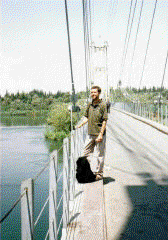 Dier es Zor, the Euphrates
Dier es Zor, the Euphrates
The heat and the journey had taken its toll on Carla and she just collapsed onto the bed in our hotel in Palmyra, but I went out in the fading sunlight to take a few photos of the ruins in twilight and at sunset. This was the only time I'd had any problems with the locals. Some young local boys did everything they could to disturb me while I was trying to take pictures, jumping up in front of the camera and pulling at my arm, asking for money. Fortunately their hassling didn't last long, and didn't spoil our overall impression of the Syrians as being a very helpful, friendly people, not in the least bit anti-Western, but very much aware of the bad press the country has had because of small groups of extremists, fanatics and terrorists.
The dinner that evening was disappointing. The restaurant owner's son was continually sent out for more provisions every time we ordered anything, a sure sign of the dramatic drop in the number of tourists in the area (which was mostly to our great advantage, of course, as not only did we have hardly any problems finding hotel rooms, eating places and so on, but also prices had fallen in the main due to greater competition). We walked a little around the town in the evening, eventually having a sweet pancake at the aptly-named Pancake House, a small café run by a Syrian and his Romanian wife … but the pancakes were enormous and stuffed with ice-cream and fruit and it was quite an effort to finish them.
We got to bed reasonably early and were up at 5:45 the next morning, and out of the hotel half an hour later. We were at the ruins by 6:30 in perfect light for photography and in ideal temperatures. It was a deliciously cool start to our exploration of the ancient Roman city of Palmyra, though just an hour later it was starting to warm up (but still a long way off the 48°C that the place reached at midday). In its heyday, Palmyra was a vitally important town at a junction at the end of the silk route, and it controlled much of the silk trade and other trades in the area and throughout the Middle and Far East. Like its smaller and sleepier modern-day partner, Tadmor, it is built on the edge of large and very luxuriant oasis, providing food and drink for the population. Abandoned in the fifth century, the ruins of Palmyra are still a wonderfully impressive sight. The main colonnaded street stretches over a kilometre, with most of the tall columns still standing, especially in the first half. Along the street are triumphal arches, an enormous tetrapylon (a group of four four-columned arches) at a crossroads, and a nymphaeum. Slightly off the main road are a forum, an agora, a large amphitheatre (partly reconstructed and used for a May festival), a banqueting hall and much more besides. We spent nearly 2½ hours just wandering around the site, also admiring the wonderful views of the Arab castle on a nearby hilltop. We then went to one end of the colonnaded street to visit the temple, a massive complex dedicated to the Roman god Bel. The remarkably well-preserved inner sanctuary even had highly-decorated parts of the roof intact.
On leaving the Temple of Bel, we hired a guide to take us to see the valley of the tombs which is only open at special hours. A unique feature of Palmyra are the 1st- and 2nd-century funeral towers dotted along a valley to the south of the city. The towers, often belonging to important families, were designed to take up to 400 corpses in tiered burial compartments on three to four floors. The burial compartments would have been closed with a square stone panel, usually carved with a bust of the deceased, but most of these panels have disappeared (or in the case of the Temple of Elabel which we visited, they are in a Copenhagen museum as a Danish archaeologist got his hands on them a couple of hundred years ago). Nevertheless, the elaborate decorations on the walls and ceilings are very much in evidence, and some of the painting on the lower-floor ceiling is still visible. We then went to see an underground tomb - the Tomb of the Three Brothers - which despite being underground has similar tiered burial compartments. Underground burial came in a century or so later, and the quality of the decoration is slightly better. A couple of large funeral panels, one of the three brothers, are still in the tomb and the workmanship is excellent. In addition, the apse has exceptional frescos depicting the story of Achilles.
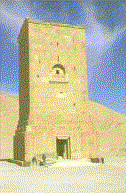 Palmyra, Temple of Elabel
Palmyra, Temple of Elabel
We were back at the hotel by 11 o’clock, the temperature having become pretty hot by then. By prior arrangement, we had a very late breakfast on the hotel patio, then checked out, and by 1 o’clock we were at the coach stop, ready to catch a coach to Damascus. Another three-and-half hours on the coach - fortunately all the long-distance coaches are quite modern and air-conditioned in Syria - and we were arriving in the capital. The final leg of our journey through Syria was mostly uninspiring rocky desert, very different from the busy city we found ourselves in. It took eight attempts to find a hotel in Damascus, much to our surprise after our experience elsewhere in the country, but we have since discovered that as well as business visitors, the city gets vast numbers of Arab pilgrims, especially from Iran, coming to the Damascus mosque and its shrines. Eventually we found a rather dingy room in a hotel, which we took just for one night. After showering, we immediately went out and started walking round the city looking for another hotel. We must have visited 15, but either they were full, or they were too expensive, or too cheap and nasty, or had very poky rooms, or they didn’t want us because we weren’t married. A bit disgruntled and very tired, we had a meal and went back to our hotel.
The next day (Friday, 8th August) we asked to change rooms in the hotel where we were staying and got a much lighter room on the second floor which was pretty clean, with en suite bathroom and balcony. It would have been fine, but the room had a distinctly “cheesy” smell, mainly coming from the carpet. We took it, and left all the windows open while we went out, and indeed some of the smell had gone when we got back later in the day. As it was Friday and most things were closed, we went to visit the nearby National Museum. Although its pieces are poorly displayed, often dusty and very badly labelled, the treasures on show are truly exceptional. And since we had already visited much of Syria, we understood much of the background and knew of the places many artefacts had come from - for example, the very best carvings from Palmyra were all in the museum. I was particularly fascinated by some very early written tablets, some using the world’s first (cuneiform) Ugarit alphabet. But there was just so much: prehistoric items, fabulous 4000-year old stone figures from Mari (near Dier es Zor), a reconstructed room from an Ottoman palace, wonderful carvings, Islamic calligraphy, basalt statues, incredible funeral loculi from Palmyra (as well as a reconstructed underground tomb from the city) and a reconstructed third-century synagogue covered with deeply-coloured frescos depicting Bible stories (despite the Talmud’s ban on depicting human forms). We spent four hours in museum, but could easily have spent more! We also visited the mosque next door and a crafts courtyard in part of the mosques outbuildings. The prayer hall of the mosque was closed and the courtyard and gardens in front of the mosque are used to display fighter aircraft belonging to the nearby military museum, quite a disturbing combination!
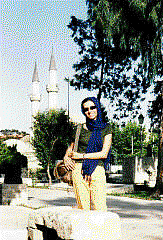 Damascus, Takkleyeh Mosque
Damascus, Takkleyeh Mosque
The next morning, we paid a visit to the tourist information office to get a bit of help for Carla in trying to contact a long-lost friend of hers (who she’d met while studying English in England many moons ago), in addition, while other people were getting fixed up with hotel accommodation we also chipped in and booked a room for the following night in a nicer hotel that had been full when we first visited it … so that at least our last night in Damascus would not have so much of a “cheesy” smell to it! After the tourist information office, on our way to the old city we stopped off for our usual mid-morning breakfast, a massive fruit juice, and before too long we were skirting the Citadel and entering the old city through the wide, elegant Hamideyeh souk. Lined with expensive and fashionable shops, we made sure to stop at Bakdash, the top ice-cream shop in Damascus, where we had the most wonderful ice-cream. Delicious cones are filled with plain ice-cream (the workers wear rubber gloves and throw hand-scoops of ice-cream into the cones), then rolled in crushed pistachio nuts … mmmm!
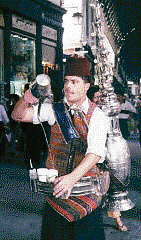 Damascus, Water seller in Hamideyeh souk*
Damascus, Water seller in Hamideyeh souk*
Before too long we arrived in the heart of the old city, reaching the Roman arch that was once the entrance to the temple (where the mosque now stands). We wandered through many of the side souks, stopping off first at the Azem Ecole, a wonderful Ottoman style building now used as an antiques and souvenir shop, and then we visited the opulent Azem Palace, the residence of the Ottoman governor. A film in costume was being shot while we were there, so although some of the palace was closed, we got an interesting insight into Syrian film-making. Like most Ottoman palaces, it is built around a series of courtyards, mostly with fountains in the middle. The highly decorated rooms housed displays of local crafts and craftsmanship, though the wonderful wall and ceiling panelling were the highlights of the place.
We wandered a bit further, reaching the Khan As’Ad Pasha, only to find the enormous doorway to the trading court closed. A bit disappointed we were turning away when the door opened slightly and a worker beckoned to us to go inside. The khan is being restored, and he was making a bit of extra money on the side by showing tourists around. And it was an experience not to be missed. A central collapsed dome is surrounded by eight other soaring domes, all supported on sturdy horizontally-striped black-and-white pillars. Around the sides are galleries and traders’ offices, all eerily empty. The worker showed us upstairs and also onto the roof where we got a fascinating view of the roofs of the old city. A little balcony also looked out onto the busy souk below, a wonderful bird’s-eye view of the bustle of the city at work.
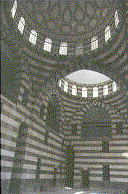 Damascus, Khan As'Ad Pasha
Damascus, Khan As'Ad Pasha
The next day (Sunday 10th August) after changing hotels we explored the old city further. Browsing the souks always took up much longer than planned, but after a late falafel sandwich for lunch we headed for the main Damascus mosque, the Ummayad or Great Mosque. The mosque has a fascinating history, first being a Roman temple, then a Christian basilica, then a shared place of worship, half a mosque and half a church, and then finally just a mosque, the fourth most important mosque in the Muslim world. We first visited the unpretentious shrine of Saladin, then entered the vast main courtyard, 120 metres wide and 50 metres long, surrounded by a tall arcade and with views of its three lofty minarets (in various styles, one having started life as a church tower!). Much of the original mosaics on the arcades and facade of the mosque have been lost after fires and earthquakes, but the remaining sections are magnificent. The hexagonal treasury on pillars is also covered with intricate gold mosaics. Inside the mosque is a similar shape and size to the courtyard, with two sets of width-ways columns dividing it into three wide aisles. People were sitting on the carpeted floor in groups inside the mosque, some praying, some chatting, some having a picnic, some playing with children. The main shrine inside is a green-glass structure housing the head of St. John the Baptist, a figure also revered by Muslims, while the main shrine in a mosque-within-a-mosque off the courtyard houses the body of a figure revered by Shi’ites and crowded out with pilgrims mainly women from Iran cloaked head to foot in black!
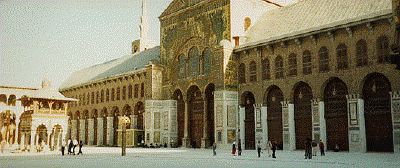 Damascus, Great Mosque
Damascus, Great Mosque
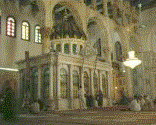 Damascus, Shrine of St. John the Baptist in Great Mosque
Damascus, Shrine of St. John the Baptist in Great Mosque
A guide we met in the mosque offered to take us on an hour’s walking tour of the eastern part of the old city, the part we still had to see, so we accepted his invitation. It was quite a route march, first through the Jewish quarter which now has a lot of abandoned buildings, still owned by the Jews even if most of them have now moved to Israel. Walking round some of the perimeter walls, we eventually got to Bab Kisan, an old gate of the city where St. Paul escaped by being lowered from the walls in a basket. The gate is now the entrance to a small Orthodox chapel which we also looked in on. A bit further on and we got to a church built on the site (and incorporating some of) the house of Ananais, the man who was called on to baptise Saul/Paul. This chapel is now a small Roman Catholic church, with a Chicago priest looking after the place. We then walked back through the Christian quarter with its array of churches and chapels of all sects and denominations. Rather tired, we eventually got back to the central area of the old city, ready to treat ourselves to a meal in the courtyard of Jabri House a wonderful old Ottoman house where the tables are surrounded by vines and fountains. But although the setting was delightful, the food was not as good as we’d had elsewhere, and many of the things we wanted to try were “off”! We remedied the matter with another wonderful ice-cream from Bakdash on our walk back to the hotel!
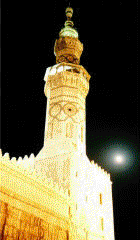 Damascus, Great Mosque in the moonlight
Damascus, Great Mosque in the moonlight
The next day we packed our bags and checked out of the hotel in the morning, but left our bags at the reception for a last few hours in Damascus. Carla again tried to contact her friend in Damascus, but eventually discovered that he was away on business. Our last mid-morning breakfast on freshly squeezed fruit juice was followed by a last look round the souks, a last falafel sandwich and a drink in an old hamman (steam baths) that had been turned into a café.
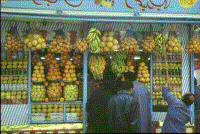 Typical Syrian fruit stall
Typical Syrian fruit stall
We got to the bus station at a bit before 5 o’clock and found the area where we could get a service taxi to Baalbek in Lebanon, our last stopping place on our tour. There are no buses plying this route, but service taxis leave as soon as they get a full complement of passengers. Unfortunately it took us two hours before we were joined by another three passengers (after we’d also been passed from one driver to another) and we eventually set off. We had hoped to arrive in Baalbek by 7:30-8:00, but it was nearly 9:30 when we arrived. The journey had been quite easy and we’d had no problems at the borders, but we were tired and sticky after the trip and needed a quick wash. By this time it was 10 o’clock and as it was so late we decided to eat in the hotel’s dining room, but were told it had already closed. So we had to walk into the nearby town, finding almost everything closed. Our dinner that night was at the only place we could find open, a sandwich bar, where we had a fish sandwich. But if the meal was basic, the hotel accommodation was something else. We were staying at the Palmyra Hotel, built 120 years earlier to accommodate European visitors coming to see the splendid ruins at Baalbek. Though a bit dilapidated in places, and with well-used beds and chairs (and antique plumbing), the hotel still had all the charm of its era, and like the Baron Hotel in Aleppo boasted a number of illustrious guests. Our large room looked out across to the floodlit ruins, and a large balcony next door to our room above the entrance porch had seating and splendid views of the site, whetting our appetites for our visit next day.
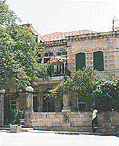 Baalbek, Palmyra Hotel
Baalbek, Palmyra Hotel
On arriving at the entrance to the Roman temples, we were appalled to see a modern construction housing propaganda material about the Intifada - a reminder that Baalbek is in the infamous Bekaa valley where the Hezbollah used to have their stronghold. But once we got into the ruins, things were very different. A flight of stairs leads to 50-metre wide monumental entrance or “propylaea”, with its soaring columns, which then leads into a hexagonal courtyard surrounded by arcades where people would gather and where animals would be prepared for sacrifice. This hexagonal courtyard leads into the vast great court nearly 80-metres square. Unfortunately the court is used for a summer festival, and a stage and tiered seating had been erected in a way that can only be described as criminal, totally obstructing any views of the courtyard, and even covering the elaborately carved basins where the animals were cleansed and ablution pools. Worst of all was the way a tall altar was used as a lighting tower. We were distressed by this state of affairs, and quickly moved on to the main Temple of Jupiter, a massive structure of which little remains. However, in one corner stand six enormous columns, the largest ever erected in the Roman world, each 20 metres high and 2.5 metres wide at their base. In addition they are still surmounted by very elaborately carved entablatures. We could examine other fallen entablatures close-up and see how marvellously decorated they were.
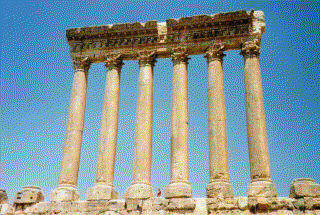 Baalbek, Temple of Jupiter, six enormous columns*
Baalbek, Temple of Jupiter, six enormous columns*
Alongside the Temple of Jupiter is the slightly smaller, but almost complete Temple of Bacchus. Surrounded by columns, its inside walls all stand, though the wooden roof is of course no longer there. The entrance portal is particularly richly carved, and the inner sanctuary still has a sense of awe to it. Underneath the whole complex in vaulted chambers is a fascinating museum detailing the history of the site and the excavations undertaken.
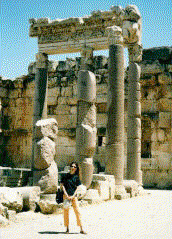 Baalbek, corner of Great Court
Baalbek, corner of Great Court
In addition to the temples, the town has many other Roman remains dotted here and there, and we had our lunch in a grassy garden, under the shade of walnut trees heavy with fruit, looking out towards the colonnaded street. We felt we were in paradise, not an area which is often painted as being hell on earth! We could hardly draw ourselves away, but had to do so to get an afternoon bus back to Beirut. It was an interesting drive through the very fertile Bekaa valley (part of the fertile crescent), then into the very high Lebanon mountains with their cedar trees, and then a twisty busy road down to the coast.
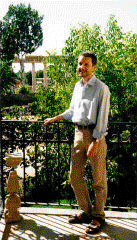
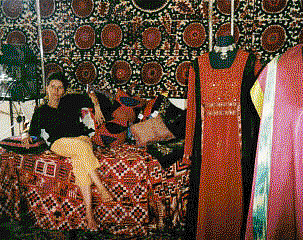 Baalbek
Baalbek
A little before 7 o’clock we returned to the “So Far” restaurant we’d eaten in more than two weeks earlier and were welcomed by the owner. We had a drink and asked if we could leave our bags while we walked round a bit before returning for dinner. He very readily and kindly agreed, and off we went for a walk around. After dinner we did the same thing, and then after talking to some of the friendly regulars in the bar-cum-restaurant, in particularly a garrulous chap from Oman, we set off at about 1 o’clock in the morning by taxi for the airport (our flight left at 4 in the morning!), not really ready to return home … but with plenty of fascinating and pleasant memories of a marvellous, if very intense holiday.
Home |
Publications |
Dictionaries |
English Lang. |
Art Insights |
Travel |
Links | ||||||
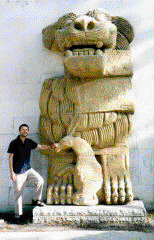
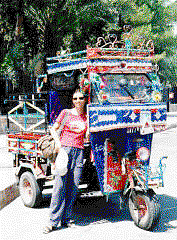
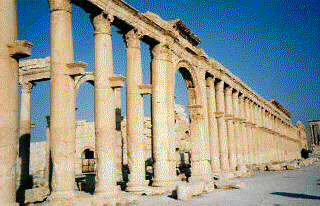
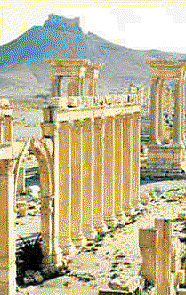
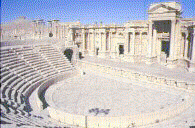 Palmyra*
Palmyra*